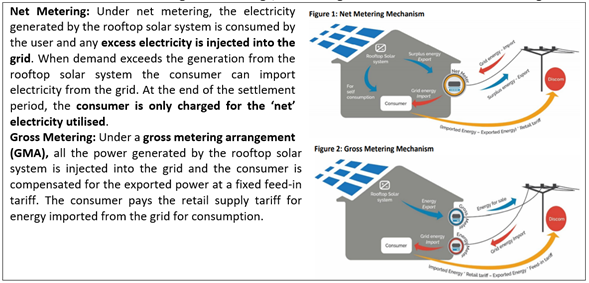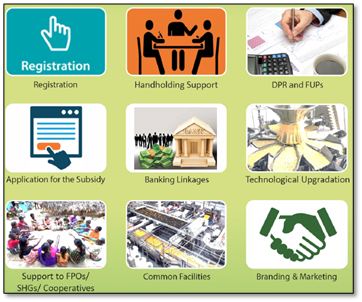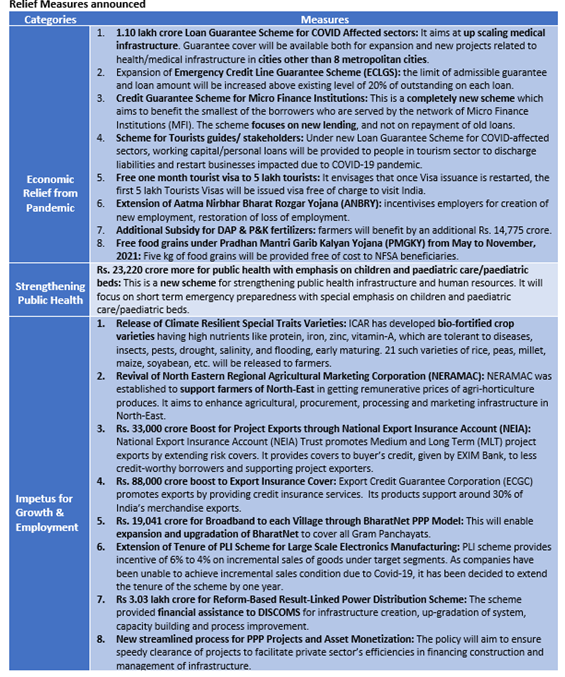Monday, 5th July 2021
Technology Innovation Platforms
In News
Ministry of Heavy Industries and Public Enterprises launched six Technology Innovation Platforms which will focus on development of technologies for the globally competitive manufacturing in India.
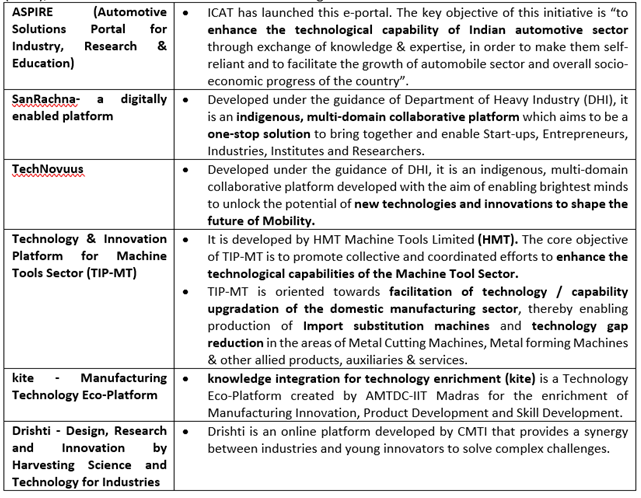
The Six Technology Platforms
They have been developed by IIT Madras, Central Manufacturing Technology Institute (CMTI), International Centre for Automotive Technology (ICAT), Automotive Research Association of India (ARAI), BHEL and HMT in association with IISc Bangalore.
Significance of these Platforms
- These platforms will facilitate exchange of knowledge with respect to research & development and other technological aspects.
- These platforms will help in bringing all India’s technical resources and the concerned Industry on to one platform to kick start and facilitate identification of technology problems faced by Indian Industry and crowd source solutions for the same.
- They will facilitate the development of the key ‘mother’ manufacturing technologies' which will cover manufacturing sector, capital goods and mobility together for current and future needs.
https://pib.gov.in/PressReleasePage.aspx?PRID=1732263
UDISE+ Report 2019-20
In News
Union Education Minister released the Report on United Information System for Education Plus (UDISE+) 2019-20 for School Education in India.
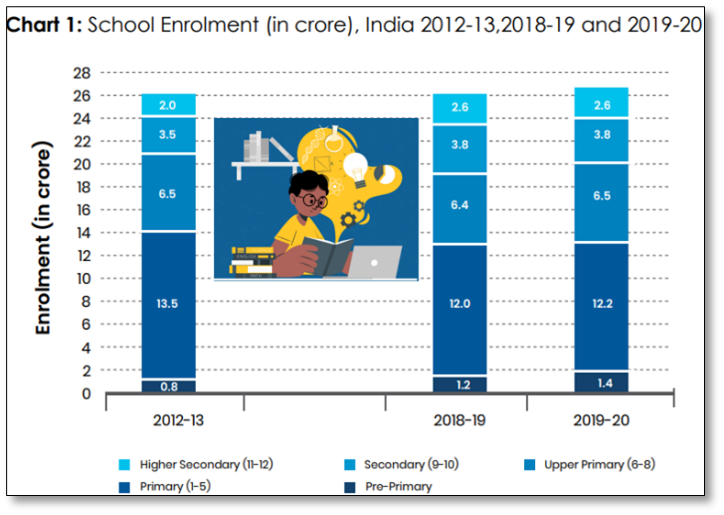
About the UDISE and UDISE+
- UDISE+ is basically an Information Management System, an improvised version of Unified District Information System for Education (UDISE), which was launched by integrating the District Information System for Education (DISE) and Secondary Education Management Information System (SEMIS).
- It may be noted that the pre-primary data in the UDISE+ system does not capture the pre- primary enrolment of the Early Childhood Care and Education (ECCE) system run by the Ministry of Women and Child Development through the Anganwadi centres or standalone pre-primary education centres run by different kindergartens. It covers only the enrolment in pre-primary classes of different categories of schools.
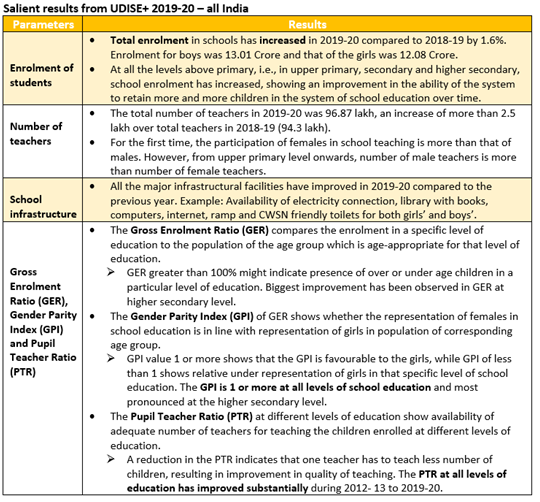
Source: https://www.education.gov.in/sites/upload_files/mhrd/files/statistics-new/udise_201920.pdf
Nagaland declared 'disturbed area' for 6 more months under AFSPA
In News: The Ministry of Home Affairs has notified that the area comprising the whole of Nagaland is in a disturbed and dangerous condition and the use of armed forces in aid of the civil power is necessary in the region.
What is a ‘disturbed area’ and who has the power to declare it?
- A disturbed area is one which is declared by notification under Section 3 of the AFSPA.
- An area can be disturbed due to differences or disputes between members of different religious, racial, language or regional groups or castes or communities.
- The Central Government, or the Governor of the State or administrator of the Union Territory can declare the whole or part of the State or Union Territory as a disturbed area.
- The Ministry of Home Affairs would usually enforce this Act where necessary, but there have been exceptions where the Centre had decided to forego its power and leave the decision to the State governments.
AFSPA in Nagaland:
- The AFSPA has been in force in Nagaland for decades and was not taken back even after a framework agreement was signed in 2015 between the government interlocutor and Naga insurgent group NSCN-IM general secretary in the presence of the Prime Minister.
What does the AFSPA mean?
- The Act gives armed forces the power to maintain public order in “disturbed areas”.
- They have the authority to prohibit a gathering of five or more persons in an area, and can use force or even open fire after giving due warning if they feel a person is in contravention of the law.
- If reasonable suspicion exists, the army can also arrest a person without a warrant; enter or search premises without a warrant; and ban the possession of firearms.
- Any person arrested or taken into custody may be handed over to the officer in charge of the nearest police station along with a report detailing the circumstances that led to the arrest.
- Presently AFSPA is operational in Assam, Jammu and Kashmir and Ladakh, Nagaland, Manipur (excluding seven assembly constituencies of Imphal) and parts of Arunachal Pradesh. The Centre revoked it in Meghalaya in 2018 and Tripura withdrew the AFSPA in 2015.
How has this Act been received by the people?
- The Act has been involved in controversies, with human rights groups opposing it as being aggressive.
- Manipur’s Irom Sharmila has been one of the staunch opponents, going on a hunger strike from 2000 to 2016.
- Also, Justice Jeevan Reddy Commission (2005) had recommended the repealing of AFSPA.
- In 2016, the Supreme Court ruled that armed forces cannot escape investigation for excesses in course of discharge of their duty even in “disturbed areas”.
Primary source: https://www.thehindu.com/news/national/what-is-afspa-and-where-is-it-in-force/article23648102.ece
Covid-19 and MSMEs
In News
Two consecutive COVID-19 pandemic waves have ravaged all the sectors, but it is the micro small and medium enterprises (MSMEs) that have borne the brunt of the coronavirus.

What are MSMEs?
- Definition: MSMEs are defined as “all enterprises engaged in production of goods pertaining to any industry specified in first schedule of Industrial (D&R) Act, 1951 & other enterprises engaged in production and rendering of services subject to limiting factor of investment in plant & machinery and equipment respectively
- Importance of MSME in Economy: MSME sector is considered as the backbone of Indian economy. They are spread across rural and urban areas and are equally represented in the manufacturing, trade and services sectors.
- Contribution to Socio-Economic development: Two thirds of MSMEs are operated by socially vulnerable groups (Scheduled Caste/Scheduled Tribe/Other Backward Classes) and 20% by women.
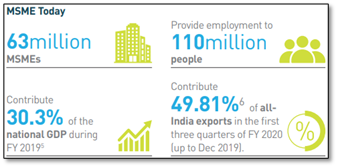
How has Covid-19 impacted the MSME sector?
- Disproportionate Impact: Preliminary analysis shows that median net sales of MSMEs fell by 47% (y-o-y) during Q1 FY21 as against a 43% contraction for large companies. While the large companies have reported an 8% median growth in net sales during Q3 FY21, MSMEs have reported only a 2% growth.
- Reduced operating Capacity: After the lockdown, many MSMES were operating at an average of only 11% of capacity, with 56% producing nothing at all. As a result, many MSMEs had to pause or entirely shut their business. This pause in business is more prominent among MSMEs in metros cities and those in the retail and manufacturing verticals.
- Supply/Demand Fluctuations: MSMEs faced a shortage of raw material due nationwide lockdown, resulting in halt of production, ultimately affecting the entire supply chain. There has also been fundamental changes in consumer behaviour and hence demand patterns, due to reduced purchasing power and constrained supply. This led to a vicious cycle of supply/ demand crunch.
- Credit Vulnerabilities: The Indian MSME sector faces a credit deficit of $240 billion. Due to poor demand, market uncertainties, and the high-risk profile of the sector, banks are cautious about lending to them. Also, MSMEs often do not maintain official business documents, account statements, and tax returns that banks require to check for potential credit risks.
- Despite the measures taken by the government to ease the credit constraints of MSMEs, the outstanding value of MSME loans from commercial banks as a percentage of GDP stands at 6.4% in India, according to the 2019 data from the IMF.
- Missing out on Government Interventions: According to the Economic Census data, over 95% of firms employed fewer than five workers, and 94% were not registered with the government. Thus, it is unlikely that these small firms contribute to EPF and may not benefit from the Government’s contribution to EPFO. As more than 81% MSMEs are self-financed with only around 7% borrowing from formal institutions and government sources, they may not benefit from Credit market interventions (cheaper loans, increased limits on NPAs).
Measures by the RBI and government
- Special liquidity facility of Rs 16,000 crore: The RBI has decided to extend a special liquidity facility of Rs 16,000 crore to Small Industries Development Bank of India (SIDBI) for on-lending/refinancing through novel models and structures.
- Resolution Framework: Individual borrowers, small businesses and MSMEs having aggregate exposure of up to Rs 25 crore are eligible for this framework. Restructuring of loans under this framework needs to be invoked up to September 30 and shall have to be implemented within 90 days after invocation
- Credit to MSMEs: The Scheduled Commercial Banks have been allowed to deduct credit disbursed to new MSME borrowers from their net demand and time liabilities (NDTL) for calculation of the CRR.

Steps needed for Resilient MSME Sector
- Access to finance: Incentivising MSMEs to adopt formal modes of credit, enabling them to maintain financial records and registration with the government can ease their immense load of credit crunch.
- Digital transformation: Through digital adoption and technology access, MSMEs can modernize not only route to market and audience access, but streamline payments, obtain financing, and expert advice, all aiding their growth, and necessary to match the Government’s vision of enabling this key sector. Cisco India study reveals that the digitization of SMEs could add up to $158-216 billion to India’s GDP by 2024.
- Access to markets: Business information portals can play a huge role in expanding market access for firms by mitigating the problems of information asymmetry and reducing the sunk cost of entering new markets. The probability of a firm exporting to new markets increases by 0.07% with each additional day of time spent on a business information portal. As, over 80% of Indian MSMEs that do not use any marketing or sale intelligence tools, the government and export promotion agencies need to incentivise MSMEs to use business information portals to improve their access to markets.
- Reforming Supply Chain: Supply-side interventions ensuring that the MSME sector has access to raw materials and robust downstream supply chains would not only help mitigate production shortages in the health and the essential goods sector, but given its size, also potentially slowdown the adverse impact on the Indian economy as a whole. The Government of India has already appealed to MSMEs to register and sell in the Government’s e-marketplace.
Conclusion
In a way, covid-19 is a watershed moment that may lend itself to accelerated business transition for India’s vast MSME sector. While this is no silver lining, the reality of the situation has forced businesses to look at any means necessary to adapt to grow. According to McKinsey, a program of targeted reforms can significantly shore up economic fundamentals by enabling greater productivity in several sectors, and creating the 90 million non-farm jobs India needs to create by 2030.
Question: Analyze the impact of Covid on MSMEs. Suggest ways to revive the MSME sector.
Primary Sources: https://www.livemint.com/opinion/online-views/opinion-covid-and-its-impact-on-economy-and-msmes-11603604611652.html
https://news.sap.com/india/2021/04/making-msmes-competitive-post-covid-19/
https://www.iimb.ac.in/sites/default/files/2020-05/MSME_sector_critical_times_Covid-19.pdf
http://nocci.in/Impact%20of%20Covid%2019%20on%20MSMEs.pdf
Secondary Sources: https://www.outlookindia.com/outlookmoney/talking-money/covid-19-and-its-impact-on-msme-in-india-4683
https://msme.gov.in/know-about-msme
http://www.igidr.ac.in/wp-content/uploads/2021/02/opinionPaper.pdf
https://sidbi.in/AnnualReport201920/msme-outlook.php
Tags- , , , ,
This Day in History- Dr. Lalji Singh
On 5th July, 1947, Dr. Lalji Singh, an Indian scientist, popularly known as the "Father of Indian DNA fingerprinting" was born. Dr. Singh was one of the leaders instrumental in making DNA fingerprinting mainstream in India, both at the level of research as well as for forensic applications. DNA fingerprinting, also called DNA typing, DNA profiling, genetic fingerprinting, genotyping, or identity testing, in genetics, method of isolating and identifying variable elements within the base-pair sequence of DNA (deoxyribonucleic acid). It is used as evidence in the legal system of India. It used to establish a link between biological evidence and a suspect in a criminal investigation. Singh also served as the 25th Vice Chancellor of Banaras Hindu University (BHU).
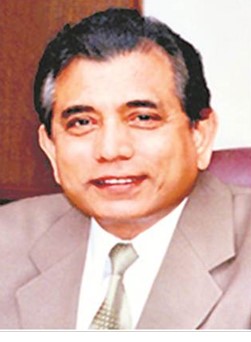
Sources: https://www.britannica.com/science/DNA-fingerprinting
Image of the Day -Fire on the Ocean Surface
This is the image of the fire on the ocean surface west of Mexico's Yucatan peninsula that has been extinguished. A fire broke out in the Gulf of Mexico early on July 2 sending bright orange flames onto the water after a gas leak in an undersea pipeline of state-owned oil company Petroleos Mexicanos or Pemex. The fire took more than five hours to fully put out. Bright orange flames jumping out of water resembling molten lava was dubbed an "eye of fire" on social media due to the blaze's circular shape, as it raged a short distance from a Pemex oil platform.

Valmiki Tiger Reserve (VTR)
- Context: Spotting of 150 vultures at VTR, prompting a conservation plan for vultures.
- VTR is located West Champaran district (Bihar) along the India-Nepal border.
- It is the only forested region in Bihar and forms easternmost limits of Himalayan Terai forests in India.
- Apart from being an important tiger reserve, it is also known for the Tharu tribal community residing in the region.

https://wildfact.com/forum/topic-tiger-reserves-in-india?page=3
Indrajaal
- Context: India’s first indigenous drone defence dome called Indrajaal developed.
- This drone defence dome has the capability to autonomously protect an area of 1000-2000 sq km against the aerial threats by assessing and acting on aerial threats such as UAVs, loitering munitions, and Low- Radar Cross Section (RCS) targets.
- Salient features of Indrajaal:
- Real-time situational awareness
- Integrated and Intelligent meshed network
- Integrated all current weapons suite and infrastructure
- Honeycombed cell structure for seamlessly built
- Synergic combination of 9-10 technologies
- 24×7 persistent and autonomous monitoring, action and tracking
- It has been developed by Hyderabad-based technology R&D firm Grene Robotics

Kalbeliya tribe
- Context: Kalbeliya dance in limelight due to chendavia app
- Kalbeliya tribe people were traditionally nomadic people and professionally snake handlers
- Kalbeliya dance is expression of Kalbeliya way of life and a part of UNESCO cultural heritage.
- While the females dance, the men play music and provide for the tunes for the dance.
- Through Kalbeliya songs, traditional stories and culture is shared with the listeners and viewers.
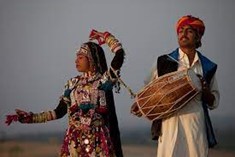
https://www.indianeagle.com/travelbeats/gypsy-of-rajasthan/
Climate pledges: Where they stand and what they mean
Essence: This article is written in backdrop of passage of Paris Agreement as a law by few countries. This causes difficulty to analyse its impact due to broad definitions of “net-zero” and leaving room for different interpretations which can be seen in EU’s and China’s pledges. Besides, there is a variation in companies net-zero goals and also, question of equity regarding timeline to achieve carbon neutrality. The major contributors to emissions have set less ambitious targets putting pressure on developing countries. Recently, the US has committed to increasing its contribution to climate fund but how the target will be achieved is not defined. Also, the question of domestic versus international contributions to emission remains. Supporting investment in dirty industries abroad would shift the burden of adaptation and mitigation to less developed and vulnerable countries in future.
Why should you read this article?
- To know the definition of net-zero and also, why broad definition of net-zero is a problem.
- To understand the issue with domestic versus international contributions to emission.
- To understand, how investment in dirty industries abroad would shift the burden to less developed countries in future.
Article Link: https://www.orfonline.org/expert-speak/climate-pledges/
Why the dairy sector needs more private players
Essence: Editorial is providing insights into India’s dairy sector. Recently, Amul raised its milk prices for consumers by Rs 2/litre and this became a national news. Many in the media are debating how this will push up CPI further, causing inflationary pressures and RBI may change its “accommodative stance” on monetary policy.
Milk is our biggest agri-commodity in terms of value, greater than paddy (rice), wheat, and sugarcane combined. India is the largest producer of milk in the world with an estimated production of about 208 million tonnes in 2020-21. Overall growth in the dairy sector for the last 20 years has been between 4-5 per cent per annum.
In past few years, many start-ups “dairypreneurs” have come in promising a farm-to-home experience of milk, giving quality testing kits at home & digitising the dairy supply chain. They have digitised cattle health, milk production, milk procurement, milk testing, and cold chain management through the Internet of Things (IoT) and sensor-based cloud technologies.
Why you should read this
- To know about the evolution of India’s dairy sector from traditional to technology infused one.
- It is providing insights into the importance of institutional innovation in transforming a sector, e.g. cooperative model for dairy sector.
- To understand the weightage of Dairy sector in our economy & it’s growth trajectory.
Article Link: https://indianexpress.com/article/opinion/columns/why-the-diary-sector-needs-more-private-players-7387923/
Post-pandemic rural economic recovery will depend on government’s ability to drive spending
Essence: Rural India, which was stuck in the fears of trepidation for most of May, now seems to be more optimistic as compared to urban India, as Covid cases continue to subside. Rural India has been displaying signs of a “Fast-in Fast-Out’’ phenomenon in the last few weeks. This article analyses the sustainability of these trends and suggest the possible measures which government should undertake to sustain them.
Why you should read this article?
- Understand key factors in sustaining rural economic recovery such as monsoon, terms of trade and supply-side and compassionate measures.
- Identify measures to address supply side constraints such as compassionate view of taxes on fuel and edible oils, investment in commodities, nudge NAFED to sell/release at least 15 per cent of the pulses stock in 10 days.
Article Link: https://indianexpress.com/article/opinion/columns/rural-economic-recovery-covid-pandemic-govt-spending-7389139/
China goes malaria free with multi-pronged health strategy
Background:
- China was declared “malaria-free” after it followed a seven decade-long, multi-pronged health strategy
- It was able to eliminate indigenous cases of malaria for four straight years
- This stands as a lesson for the world which has reported 230 million cases according to the World Malaria Report in 2020
Reason behind the success:
- The reason for the success has been attributed to strong political commitment and strengthening national health systems
- A multi-pronged approach was followed like providing anti-malarial medicines, targeting mosquito breeding grounds, using insecticide spraying, distributing insecticide-treated nets
- Great results have been achieved because of following “1-3-7 strategy” i.e one-day deadline to report a malaria diagnosis, confirming a case by the third day, and to take measures to stop the spread by the seventh day.
Lessons for India:
- India can follow multipronged strategy for malarial control
Share the article
Get Latest Updates on Offers, Event dates, and free Mentorship sessions.

Get in touch with our Expert Academic Counsellors 👋
FAQs
UPSC Daily Current Affairs focuses on learning current events on a daily basis. An aspirant needs to study regular and updated information about current events, news, and relevant topics that are important for UPSC aspirants. It covers national and international affairs, government policies, socio-economic issues, science and technology advancements, and more.
UPSC Daily Current Affairs provides aspirants with a concise and comprehensive overview of the latest happenings and developments across various fields. It helps aspirants stay updated with current affairs and provides them with valuable insights and analysis, which are essential for answering questions in the UPSC examinations. It enhances their knowledge, analytical skills, and ability to connect current affairs with the UPSC syllabus.
UPSC Daily Current Affairs covers a wide range of topics, including politics, economics, science and technology, environment, social issues, governance, international relations, and more. It offers news summaries, in-depth analyses, editorials, opinion pieces, and relevant study materials. It also provides practice questions and quizzes to help aspirants test their understanding of current affairs.
Edukemy's UPSC Daily Current Affairs can be accessed through:
- UPSC Daily Current Affairs can be accessed through Current Affairs tab at the top of the Main Page of Edukemy.
- Edukemy Mobile app: The Daily Current Affairs can also be access through Edukemy Mobile App.
- Social media: Follow Edukemy’s official social media accounts or pages that provide UPSC Daily Current Affairs updates, including Facebook, Twitter, or Telegram channels.

